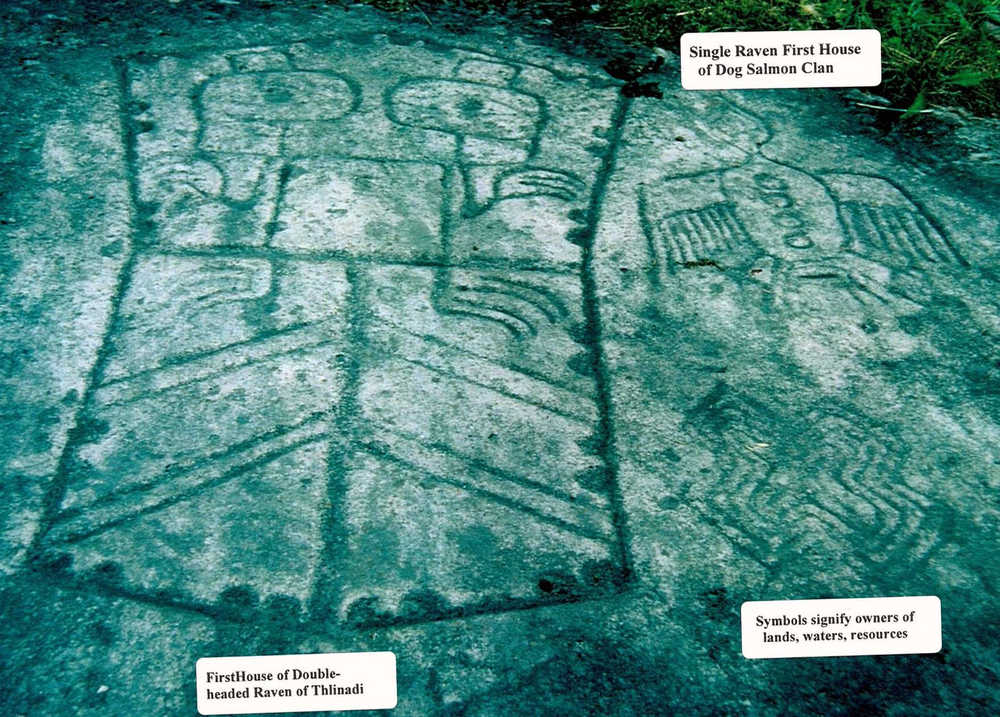Some may call Alaska “The Last Frontier,” but evidence of Alaska Natives’ thousands of years here is etched right into the rocks. Hundreds — perhaps thousands — of petroglyphs exist in Southeast Alaska alone. Some are hidden by the foliage of the temperate rainforest while others remain out of sight except on the lowest of low tides.
These petroglyphs, carvings in rock that depict a variety of images — from simple swirls to animals and clan crests — are rich in culture and history. Many had meanings related to clan territory; others could signify important events, according to Chuck Smythe, the History and Culture Director at the Sealaska Heritage Institute. The significance of some are lost to time.
George Suckinaw James Jr., whose tribal name is What Staw (Long way around Raven) is the second chair of the Kuiu Tlingit Nation. He contacted the Capital City Weekly asking to share the meaning behind his family’s petroglyphs. He is from the First House of Kuiu Island along with his father, Daat Haaw Gooch of the First Wolf House; his mother, Kain yailth Usk (Mother of all Ravens), is of the Dog Salmon Clan, the First House of Shakan (Shakan was a summer village on Kosciusko Island which lies on the northwest coast of Prince of Wales.) James said he was driven to speak about his family’s petroglyphs at Shakan to preserve their meaning for future generations.
He visited the petroglyphs this summer, when a group from the Kuiu Tlingit Nation visited a few of their known locations.
“My father pointed it out some 70 years ago,” James said of the area of his family’s carvings. “He said this is where your clan carving is. He didn’t go up and show me, just the area, because we were in a rush.”
His father did pass down the meaning behind the carvings, though. The single raven with widespread wings and what looks to be four buttons running down its length represents the Single Raven First House of the Dog Salmon Clan, his mother’s clan crest. To the left is the crest of the First House of the Double-headed Raven of the Thlinadi tribe. This crest, which is shaped like a shield and runs about four feet by three feet, was exposed to the elements and easily visible, James said.
“It signifies looking at two territories that we own,” James said of the shield crest.
The third marking, the “X” symbol, signified ownership and title to the lands, waters and resources of the area, James said, adding that this used to be common knowledge, but no longer.
People generally knew what land belonged to what clan, and the markings formalized it. Territories were well established, and if someone wanted to hunt or fish in someone else’s territory, the markings like James’ family’s were a clear indication of who they should be seeking permission from.
Petroglyphs from the Kuiu Tlingit Nation can be found on the north end of Prince of Wales, Kuiu Island in Tebenkof Bay, Noyes Island, Sumez Island and many other areas. In Shipley Bay on Prince of Wales Island, there is one petroglyph that looks like a whale coming out of the water.
Preserving the petroglyphs
One driving reason for James to bring up his family’s glyphs besides preserving their meaning is to safeguard the petroglyphs themselves. When visiting the petroglyphs of his family’s crests, he found that someone had placed their initials nearby.
“We had to let people know: don’t deface the carvings,” he said.
While any kind of markings beings applied to the glyphs is generally understood as inexcusable, James wanted the public to understand that these carvings can be harmed even by the well-intentioned. He found a group of people scrubbing down some carvings, likely to remove previous vandalism, but the act of scrubbing degrades them. They shouldn’t have done that, he said.
Chuck Smythe said SHI discourages publicity about petroglyphs, particularly their specific locations, in order to protect and preserve them. If someone does know the location of a petroglyph, SHI discourages rubbings, which can negatively impact the carvings’ depths over time.
“Try to keep its location quiet,” Smythe said if anyone finds a petroglyph. “Don’t publish it on Facebook. We don’t want them to become destination sights, or with the increase of people, it becomes more likely that something will happen to the glyphs.”
There is also the danger of the glyphs being removed. Smythe said he has spoken to people who have seen glyphs but return to their location years later only to find them gone.
Myra Gilliam, an archeologist from the U.S. Forest Service Juneau Ranger District, said they try to monitor well-known glyph sites and inventory to keep track of newly found ones. She said she has not noticed any going missing, but commented that in the past, museums were guilty of removing historic and culturally significant items, like petroglyphs, from their homes. Jane Smith, Petersburg and Wrangell District’s archaelogist, said that she had noticed a couple of glyphs going missing.
“It (Alaska) has been home for us for 10,000 years,” James said.
The marks of these clans and what meanings remain can be preserved for many more if people respect and protect the carvings.
• Contact Clara Miller at 523-2243 or at clara.miller@juneauempire.com.

